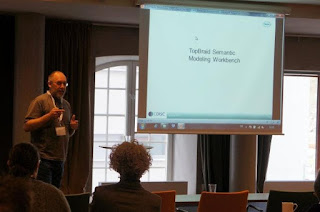After a warm and sunny day of kayaking out in the archipelago north of Gothenburg it was nice to catch up on Twitter and see the official announcement from W3C that my employeer; AstraZeneca, has joined W3C. It's actually a re-join as we joined W3C in 2006 to participate in the Semantic Web Health Care and Life Sciences Interest Group (HCLS IG).
RT @w3c: AstraZeneca joined W3C bit.ly/JXYQj9 < Yes - we are back. Kudos to @TPlasterer & @John_Reynders
— Kerstin Forsberg (@kerfors) May 27, 2012
Update 6 June: I recommend this nice slide deck for an overview of Semantic Web and Related Work at W3C, presented by Ivan Herman (@ivan_herman) at the 2012 Semantic Tech & Business Conference in San Francisco, CA, USA, 5 June.
I attended and reported back from the W3C conference in Edinburgh in May 2006 (WWW2006) and from the next one in Banff in May 2007 (WWW2007) together with my former colleague Bosse Andersson (@bbalsa). My focus was on applying semantic web standards for clinical data and in 2007 Eric Neumann (@ericneumann), one of the HCLS pioneers, and I published a W3C Note in the Drug Safety and Efficacy task force on CDISC's Study Data Tabulation Model (SDTM). And together with most of the members in the HCLS group I co-authored an important article in BMC Bioinformatics Advancing translational research with the Semantic Web.
I attended and reported back from the W3C conference in Edinburgh in May 2006 (WWW2006) and from the next one in Banff in May 2007 (WWW2007) together with my former colleague Bosse Andersson (@bbalsa). My focus was on applying semantic web standards for clinical data and in 2007 Eric Neumann (@ericneumann), one of the HCLS pioneers, and I published a W3C Note in the Drug Safety and Efficacy task force on CDISC's Study Data Tabulation Model (SDTM). And together with most of the members in the HCLS group I co-authored an important article in BMC Bioinformatics Advancing translational research with the Semantic Web.
In late 2007 I had to focus on other tasks while Bosse and colleuges in the US; Julia Kozlovsky, Elgar Pichler and Otto Ritter contiued the interactions with other parties across life science and health care in two of the HCLS groups: Linking Open Drug Data (LODD) and Translational Medicine Ontology (TMO).
In early 2010 when I returned my job focus to semantic interoperability, AstraZeneca had decided not to renew the W3C membership. To stay updated I started to use use social media as a way to engage with the semantic web and linked data community, to follow thought leaders in the intersection between eHealth and Clinical Research, and to share news and insights with colleagues.
Early 2011 Bosse and I wrote a short paper to summarise insights from AstraZeneca's engagment in W3C HCLS and in the EU project Large Knowledge Collider (LarKC). The paper, Linked Data, an opportunity to mitigate complexity in pharmaceutical research and development, starts with a look back to one of the most inspiring meetings I have been in:
During the WWW2007 conference a breakthrough of the Linked Data idea happened in a session where web experts demonstrated the power of a new generation of the web, a web of data. For us attending the session it was hard to imagine the full potential on what this idea would mean for individual scientists and for a pharmaceutical company.

